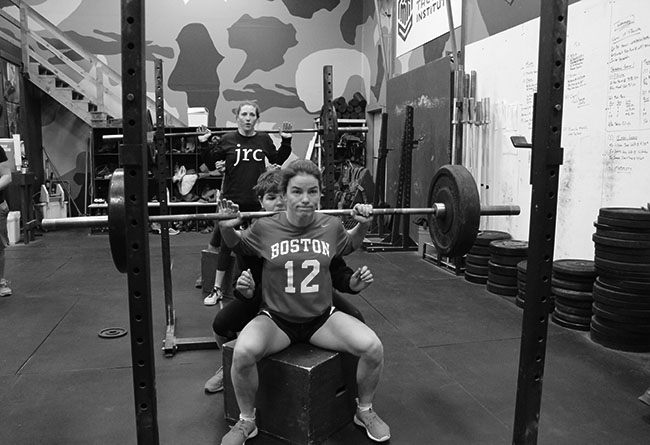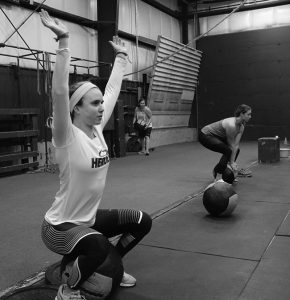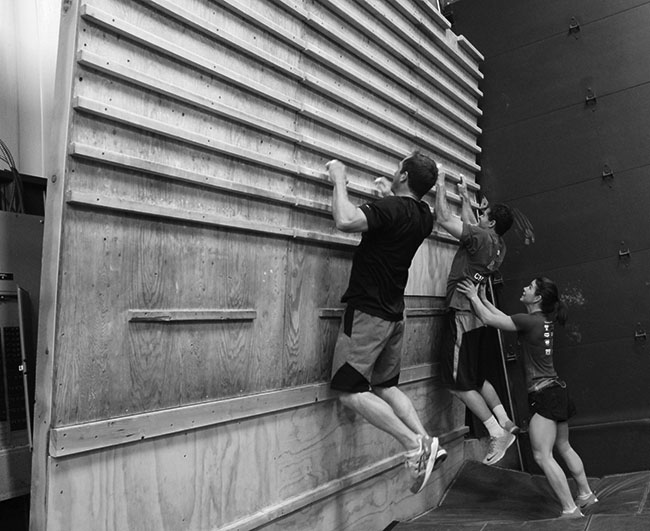
By Rob Shaul, Founder
We started a triple purpose 6-week “geek cycle” with our local lab rats mid-December at our Wyoming Facility aimed at researching three distinct areas:
(1) Female Set/Rep Schemes for 1RM Strength
Until this cycle, we’ve never looked at female strength programming separately, and in our research, could not find another study which had either. We’ve always assumed men and women would respond to strength programming the same.
However, last summer one of our mentees, Jamie Cunningham, conducted a female-specific mini-study looking at methodologies to increase pull up and heavy rucking performance, and we began to wonder is progressions built and proven for men, were the best to use for women.
Anecdotally, in coaching strength sessions with women over the years at MTI, I’ve seen that in general, women are hesitant to push 1RM efforts. There could be many reasons for this … (a) women could simply not be as interested in increasing strength as men; (b) women in general have less lifting experience, and are therefore more fearful of going heavy; (c) women have less lifting experience, and in general simply are not as familiar with barbell exercises and therefore are more hesitant to go heavy.
The mini study we’re conducting during this cycle addresses (b) and (c). We divided all our lab rats, men and women, into two strength groups, Group 1 and Group 2, and conducted 1 Rep Max assessments on the Box Squat and Push Press.
Both groups will conduct a percentage based progression, and train these two exercises two times per week. Group 1 will train heavy resistance (load) and low volume (reps), and Group 2 will train moderate resistance (load) and moderate volume (reps). We re-assessed at week 3, reset the progressions, and then will re-assess week 6 (next week).
See the charts below:

In general, for strength programming, we wouldn’t program the moderate load and moderate volume set/rep scheme.
Based on our assumptions on why some women may be hesitant to push 1RM efforts from above, we are hypothesizing that the increased time under the barbell and therefore exercise experience for Group 2 may lead to a greater 1RM improvement amongst the female athletes in that group. Based on volume alone, Group 2 lab rats will complete 3 times as many reps as Group 1.

(2) Best Way to Improve Mobility?
Over the years I’ve really struggled with the importance, concept, and application of “mobility” in our program design.
Many coaches and practitioners consider mobility a significant element of durability and early on, I was onboard with this idea. But, after a decade of coaching and working with both mountain and tactical athletes, I no longer feel mobility is a significant indicator of durability.

I’m not a big believer in mobility as a determinate of durability – so why is MTI conducting this mini-study?
First, I’m concerned I’ve become too “righteous” when it comes to this field, and in my past coaching and programming experience, every time I’ve become righteous against a theory, progression, exercise, etc., I’ve been proven wrong.
But second, and more important, I feel the “mobility” field, in general, is ripe for disruption – the thinking is stagnant, dominated by just a few individuals, and needs to be pushed forward.
Within the mobility camps, three general approaches for improving mobility have developed – (1) flexibility, and; (2) patterning, and; (3) both flexibility and patterning.
Flexibility is just what you think it is – stretching, both static and dynamic.
Patterning is a little more complex and rests on the general idea that it’s not so much flexibility that limits our mobility, but rather central nervous system pattering – or the general idea that we’ve forgotten how to fire our muscles in the proper sequences and intensities and this limits our mobility. In general, the theory is that because of so much sitting, we’ve forgotten how to fire the muscles in our mid-sections properly, and the result is poor hip and shoulder mobility.

Assessment
For this mini-study, I put all the lab rats through a mobility assessment – specifically the Overhead Squat with PVC from the Functional Movement Screen – but with an MTI Twist.
First, I had the athletes remove their shoes for the assessment – this way the different shoe heel heights would not need to be considered or accounted for in the results.
Second, in doing this assessment, if the athlete cannot achieve the standard standing on the flat floor, we raise his/her heels with a ledge, and continue to raise the ledge until they can reach the standard (feet straight ahead, elbows locked out, arms behind ears at the bottom of the squat, back vertical or nearly so in the bottom of the squat).
I chose the Overhead Squat with PVC as the mobility assessment for this mini-study as it assesses both hip and shoulder mobility concurrently.
We used 4 Heel levels:
Level A – Flat Floor
Level B – Heels raised on 5# Plastic Bumper Plates
Level C – Heels raised on 10# Rubber Bumper Plates
Level D – Heels raised on 15# Rubber Bumper Plates
Level Zero – Can’t meet the standard even with the 15# plates
We conducted the assessment on Week 1, Day 1 of the cycle, then re-assessed on Weeks 3 and 6.
After the assessment, I divided the lab rats into 3 groups for the follow-on flexibility/mobility work:
Group A (Patterning Only) completed 10-15 minutes of flexibility – only exercises at the end of each training session (4 days/week) during this cycle. They rotated through these exercises:
Group B (Flexibility Only) completed 10-15 minutes of patterning only exercises at the end of each training session and rotated through these exercises:
Group C (Combo, Patterning + Flexibility) completed 10-15 minutes of 1/2 flexibility and 1/2 patterning exercises each training session:
At the end of the cycle (Week 6) we’ll conduct a final Overhead Squat re-assessment and discern which, if any, of the groups, saw greater improvement.
(3) Campus Board Progressions
In working with rock climbers over the years, I’ve found there is always an imbalance between strength and technique, and it’s the trailing attribute which is currently limiting their climbing ability.
New climbers have more strength than technique, and often the best, most efficient way for them to improve is to simply boulder.
However, as the technique improves, at some point their strength holds them back, and they must step away from simply climbing to train if they want to improve.
Rock climbing strength is narrow – and focuses on grip and finger strength almost exclusively. Pulling strength is somewhat important, but not nearly as much as you would think. Finger strength, especially, becomes a limiter.

Over the years we’ve experimented with and built our own myriad of rock climb training apparatuses – multiple system boards and a myriad of different types of system types and wooden and plastic holds.
However, I’ve come to believe our most efficient and effective tool for climbing rock climb-specific finger and grip strength is our campus boards.
I had the campus rungs on our campus boards custom built – and they are wider and easier than those available for sale from the typical vendors. “Easier” does not mean easy – and only our most fit and experienced climbers can dyno on our smallest campus rungs. We have 3 widths of rungs – narrow, wider, and widest.
Most coaches and facilities use campus boards exclusively for feet off, hands only dyno-ing and laddering. At MTI, however, we also use our campus boards for feet-on dyno-ing, laddering and system-board intervals.
From a strength-building perspective, dyno-ing is by far the most intense and efficient. When watching an athlete dyno on a campus board, most non-climbers are impressed by the pull-specific explosive power as the climber bounces up and down the board, feet off.
But what is really impressive is the finger strength it takes to handle the forces involved -especially on our smallest campus rungs. I’ve found that most fit men with just a little familiarization, can dyno on our easiest campus Board (widest rungs) – at least for a few reps.
But move them to the hardest board (narrowest rungs) and they can barely hold on even with their feet on the board to help.
The purpose of this mini-study was to experiment with a progression to see if I could take an inexperienced climber and over the course of six weeks train his finger strength to the point he could dyno on our hardest campus board.
A couple notes about climbing and this types of fitness. First – when it comes to climbing, there is a difference between finger muscle strength and finger ligament strength. Experienced rock climbers have both – strong finger muscles and also strong finger ligaments. Inexperienced rock climbers can have relatively strong finger muscle strength, but relatively weak finger ligament strength. Popping or breaking ligaments is a major training concern for even experienced climbers.
Building ligament strength takes longer than muscle strength, meaning it’s entirely possible to develop finger muscle strength ahead of ligament strength, and risk ligament injuries – especially dyno-ing.
From a programming perspective, I must pay attention to both muscle strength improvement, and ligament improvement. Developing muscle fitness is relatively straightforward – but ligament strength development is “hidden” somewhat.
Also – how to best get new climbers to dyno? From a programming perspective, should all work be hands only, laddering and dyno-ing? Should I include interval work? How many times should we train per week? Set rep schemes, and interval times? What about campus rung size?
All of these issues/concerns went into my initial program design for this cycle. But, it was all subject to change and the programming was “fluid” as I observed what was occurring with the athletes. More on its evolution and lessons learned in a future article.
Questions, Comments, Feedback? Email rob@mtntactical.com
You Might Also Like MTI’s Leg Blaster vs Front Squats Geek Cycle
